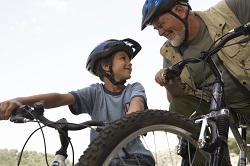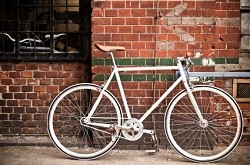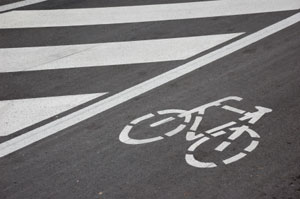Ways to Make Your Child’s Bicycle Safer
 Kids just love to ride a bike, but statistics show that bicycling can be a potentially dangerous activity, with nearly half a million emergency room visits every year related to bike accidents. Though many of the accidents are the result of lack of supervision, authorities say that safety features (or lack thereof) can also contribute to accidents. Not surprisingly, the U.S. Consumer Safety Product Commission has a specific set of design guidelines that manufacturer’s must follow when selling or marketing bicycles, with special standards for children’s bicycles.
Kids just love to ride a bike, but statistics show that bicycling can be a potentially dangerous activity, with nearly half a million emergency room visits every year related to bike accidents. Though many of the accidents are the result of lack of supervision, authorities say that safety features (or lack thereof) can also contribute to accidents. Not surprisingly, the U.S. Consumer Safety Product Commission has a specific set of design guidelines that manufacturer’s must follow when selling or marketing bicycles, with special standards for children’s bicycles.
The CSPC determines whether a bicycle must comply with the standards set for children’s bikes by looking at the wheel size, with the safety regulations varying based on wheel size. As a general rule, bikes with a 12-16 inch wheel base (as compared to the full-sized 23 inch base) must have more built-in safety features, as their users, small children, will have less strength and coordination. Here are some of the guidelines:
Balance Bicycles
The most basic type of child bike is what is known as the “balance bike.” This bicycle has no pedals, gears or drive system at all. It is designed entirely to be propelled either by the child, or with assistance from an adult. These bikes are most often used by children under the age of four. Because they are not considered road bikes in any sense, they do not need brakes or reflectors.
Sidewalk Bikes
Balance bikes fall under the broader category of “sidewalk bikes,” which are generally not intended for use on roadways. As a general rule, these bikes don’t have a wheelbase larger than 12 inches. If the height of the seat is less than 22 inches, these bikes don’t need brakes. If the seat is higher than 22 inches, the bike must have a foot brake. These bikes are considered entry-level or training bikes, and should only be used by children under the age of five. They typically have training wheels and, if they have a chain, must also have a guard.
Contact Taylor & Boguski
At Taylor & Boguski, we bring more than 70 years of combined legal experience to injured people throughout New Jersey. For a free initial consultation, contact our office online or call us at 856-200-8989.


 It’s become a far too common occurrence—a motorist parks on the street and opens the traffic-side door without looking, putting the open door directly in the path of an oncoming vehicle, or even worse, a cyclist. In a study conducted in Chicago earlier this decade, researchers found that “dooring crashes”—where bicyclist collided with the open door of a parked vehicle—accounted for almost one in five bicycle-related accidents (19.7%). A similar study in Boston found that about one in ten bicycle crashes involved “dooring.”
It’s become a far too common occurrence—a motorist parks on the street and opens the traffic-side door without looking, putting the open door directly in the path of an oncoming vehicle, or even worse, a cyclist. In a study conducted in Chicago earlier this decade, researchers found that “dooring crashes”—where bicyclist collided with the open door of a parked vehicle—accounted for almost one in five bicycle-related accidents (19.7%). A similar study in Boston found that about one in ten bicycle crashes involved “dooring.”  According to a recent study, nearly 20,000 bicyclists were injured in collisions with motor vehicles during a ten year period. Not surprisingly, 81 of those accidents proved fatal to the bicyclist.
According to a recent study, nearly 20,000 bicyclists were injured in collisions with motor vehicles during a ten year period. Not surprisingly, 81 of those accidents proved fatal to the bicyclist.